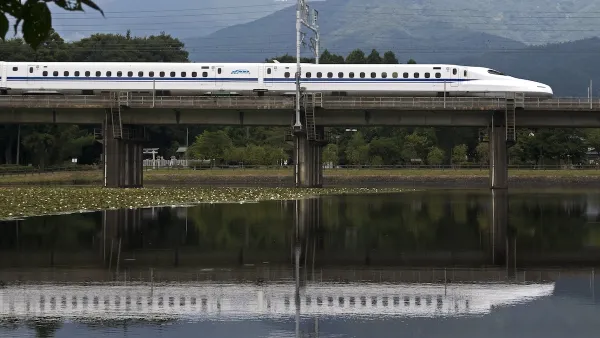As the Golden Gate Bridge approaches its 75th anniversary, John King pens an incisive comparison between the arguments against the bridge's original construction and those that have challenged subsequent high-profile projects.
Seeing common ground between the arguments raised against the construction of the Golden Gate Bridge eight decades ago - "We need more details, the details we do have can't be trusted, and there are better alternatives" - and efforts to derail high-profile projects such as the Bay Area Rapid Transit (BART) system and California's proposed high-speed rail, King observes that "little has changed in terms of the attacks that are aimed at major alterations to the landscape..."
"If there's a moral to the story of the birth of the Golden Gate Bridge, it's that there are times when change within a city, region or state comes at an exponential scale. On such occasions, the cultural status quo is threatened."
"This doesn't mean that skeptics of big plans are small-minded. Some large projects should not be built. But the what-ifs and worst-case scenarios can blind us to the fact that projects of a certain scale often reshape the landscape in ways we can't imagine. And sometimes, the landscape is the better as a result."
FULL STORY: Golden Gate Bridge construction - and indignation

Planetizen Federal Action Tracker
A weekly monitor of how Trump’s orders and actions are impacting planners and planning in America.

Maui's Vacation Rental Debate Turns Ugly
Verbal attacks, misinformation campaigns and fistfights plague a high-stakes debate to convert thousands of vacation rentals into long-term housing.

San Francisco Suspends Traffic Calming Amidst Record Deaths
Citing “a challenging fiscal landscape,” the city will cease the program on the heels of 42 traffic deaths, including 24 pedestrians.

Amtrak Rolls Out New Orleans to Alabama “Mardi Gras” Train
The new service will operate morning and evening departures between Mobile and New Orleans.

The Subversive Car-Free Guide to Trump's Great American Road Trip
Car-free ways to access Chicagoland’s best tourist attractions.

San Antonio and Austin are Fusing Into one Massive Megaregion
The region spanning the two central Texas cities is growing fast, posing challenges for local infrastructure and water supplies.
Urban Design for Planners 1: Software Tools
This six-course series explores essential urban design concepts using open source software and equips planners with the tools they need to participate fully in the urban design process.
Planning for Universal Design
Learn the tools for implementing Universal Design in planning regulations.
Heyer Gruel & Associates PA
JM Goldson LLC
Custer County Colorado
City of Camden Redevelopment Agency
City of Astoria
Transportation Research & Education Center (TREC) at Portland State University
Jefferson Parish Government
Camden Redevelopment Agency
City of Claremont




























